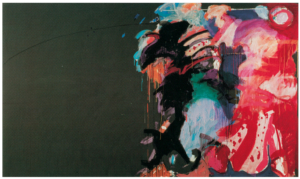
Mary Lovelace O’Neal (b. 1942, Jackson, MS)
She is known for her paintings that pair bold, monumental scale with layers of unexpected materials to explore deeply personal narratives and mythologies as well as broader themes of racism and social justice and contemporary critical debates. With roots in both Minimalist and Expressionist painting, her imagery has, over years and series, fluctuated between pure abstraction, narrative figuration, and the evocative spaces in between. Attending Columbia University’s MFA program in 1969, Mary developed her Lampblack series; creating paintings in which she applied layers of loose, powdered black pigment to large, unstretched and stretched canvases. She would then use a chalkboard eraser or her hands to disperse thin white lines over the velvety dimensions of black paint; taking inspiration from Barnett Newman and his “zip lines.” These lines meant to divide and simultaneously unite the composition, as Mary abandoned her expressionist style to instead engage in a dialogue around flatness, utilizing the color field method of soak straining.
Effacing the concept of the individual mark in favor of large flat, strained and soaked areas of color, Mary’s repeated use of black pigment acted as a response to her contemporaries within the Black Arts movement and their critique of the lack of narrative social activism within her work. Mary however, describes the lampblack paintings as “as black as they could be,” alluding to their literal blackness and linking the abstraction as a way to “give voice to the intangible elements of the human spirit.” Her use of black pigment functions as an obvious symbolism for the unfiltered exploration of racial politics in the United States. Mary makes a further point of her intentions through the titles of her artworks, stating, “My paintings and their titles speak for me. They’re not attitudes of despair; they just simply state a factual existence that continues.” Her paintings, therefore, carry a sense of optimism despite their subject matter.
(tekst Jenkins Johnson Gallery)
